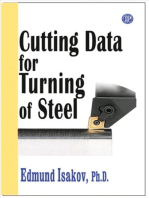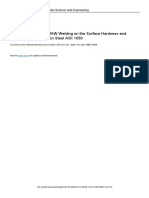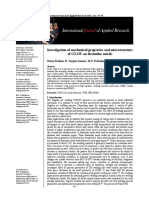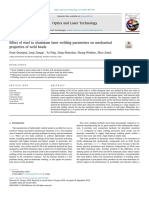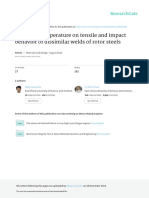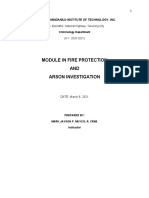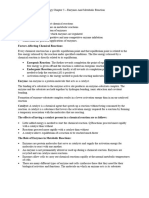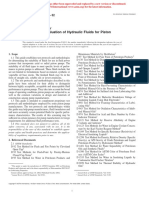Calik
Calik
Uploaded by
marceloCopyright:
Available Formats
Calik
Calik
Uploaded by
marceloOriginal Description:
Original Title
Copyright
Available Formats
Share this document
Did you find this document useful?
Is this content inappropriate?
Copyright:
Available Formats
Calik
Calik
Uploaded by
marceloCopyright:
Available Formats
UDK 621.791:621.791.053:669.14.018.
8 ISSN 1580-2949
Review article/Pregledni ~lanek MTAEC9, 47(4)403(2013)
A. CALIK, M. S. KARAKAª: EFFECT OF HEAT TREATMENT ON THE MICROSTRUCTURE ...
EFFECT OF HEAT TREATMENT ON THE
MICROSTRUCTURE AND MECHANICAL PROPERTIES
OF MARTENSITIC STAINLESS-STEEL JOINTS WELDED
WITH AUSTENITIC STAINLESS-STEEL FILLERS
VPLIV TOPLOTNE OBDELAVE NA MIKROSTRUKTURO IN
MEHANSKE LASTNOSTI MARTENZITNIH NERJAVNIH SPOJEV,
VARJENIH Z AVSTENITNIMI NERJAVNIMI ELEKTRODAMI
Adnan Calik, Mustafa Serdar Karakaº
Department of Manufacturing Engineering, Faculty of Technology, Suleyman Demirel University, 32260 Cunur, Isparta, Turkey
adnancalik@sdu.edu.tr
Prejem rokopisa – received: 2012-11-08; sprejem za objavo – accepted for publication: 2013-01-04
AISI 422 martensitic stainless steels were welded according to the ISO 15792-1 standard with austenitic stainless-steel filler.
The effects of tempering and preheating heat treatments were also evaluated. The microstructures of the welds were
characterized with optical microscopy. Mechanical properties were determined via microhardness, tensile and fatigue tests, and
compared to those of the unwelded AISI 422 steel. X-ray diffraction was used to characterize the phases present in the weld.
Chromium carbides were observed at the grain boundaries of the welds. The precipitation was caused mainly by the diffusion of
carbon into the austenitic stainless steel during the welding. The microhardness decreased from the base metal to the weld. The
tensile-strength and percent-elongation values were improved with preheating and tempering heat treatments. The highest
fatigue limit was obtained with preheating.
Keywords: welding, heat treatment, stainless steel, fatigue, hardness
Martenzitno nerjavno jeklo AISI 422 je bilo varjeno skladno s standardom ISO 15792-1 z elektrodami iz avstenitnega
nerjavnega jekla. Ocenjen je bil vpliv kaljenja in predogrevanja. Mikrostruktura zvarov je bila opredeljena s svetlobno
mikroskopijo. Mehanske lastnosti so bile dolo~ene z mikrotrdoto, nateznimi in utrujenostnimi preizkusi in primerjane z
nevarjenim jeklom AISI 422. Rentgenska difrakcija je bila uporabljena za karakterizacijo faz v zvaru. Po mejah zrn v zvaru je
bilo opaziti kromove karbide. Ve~ino izlo~anja je povzro~ila difuzija ogljika v avstenitno jeklo med varjenjem. Mikrotrdota se je
zmanj{evala od osnovnega materiala do zvara. Vrednosti natezne trdnosti in dele` raztezka so se pove~ali s predgrevanjem in s
toplotno obdelavo. Najvi{ja odpornost proti utrujanju je bila dose`ena s predgrevanjem.
Klju~ne besede: varjenje, toplotna obdelava, nerjavno jeklo, utrujenost, trdota
1 INTRODUCTION strength. For the fillet-welded and butt-welded joints the
fatigue strength is strongly dependent on the welding
For metals, fatigue failures occur more often in
procedure.8,9
welded joints than in unwelded structures. Weld defects
In spite of a poor weldability, martensitic stainless
and imperfections affect the fatigue and other mechani-
steels may be welded in the annealed, stress-relieved and
cal properties of structures.1,2 In general, fatigue strength
tempered conditions. As an alloying element, Cr has
decreases significantly with the introduction of any stress
very significant effects on the metallurgical aspect of the
raisers in metals. Machine parts contain stress raisers in
martensitic stainless steels. Cr and C are specifically
industrial applications. Fatigue cracks in structural parts added to steel to ensure the formation of martensite after
almost always initiate at geometrical irregularities.3 the hardening. Ni can be added, and it enhances both the
Weld defects and imperfections can be accepted as yield strength and ductility of these steels. The hardness
critical stress raisers in welded structures. Fatigue pro- in this type of material is dependent on the carbon
perties of welded joints are more complicated because of content.10 The carbon content can also affect the hard-
the nature of the weld. Slag inclusions, pores, undercuts, ness of the heat-affected zone (HAZ). Thus, the influ-
incomplete fusion and residual stresses all affect the ence of hardness of HAZ may be controlled with
crack initiation and crack-propagation stages of the welding characteristics. In general, the welding of the
fatigue life of a welded joint.4–6 In addition, surface martensitic stainless steels with a carbon content higher
roughness and section changes may also affect the than 0.25 % is not recommended. In the 0.05–0.15 % C
existing or newly developing fatigue cracks. The fatigue range, the hardness increases with the increasing carbon
behavior of a welded joint is influenced by the thickness concentration. Austenitic or ferritic-austenitic electrodes
of a plate as well as by the other geometrical para- are used for martensitic stainless steels. The hardness
meters.7 However, there is conflicting evidence with and ductility of a weld and HAZ vary in a welded struc-
regard to the effect of a welding procedure on the fatigue ture. To avoid this harmful effect on the welded AISI 420
Materiali in tehnologije / Materials and technology 47 (2013) 4, 403–407 403
A. CALIK, M. S. KARAKAª: EFFECT OF HEAT TREATMENT ON THE MICROSTRUCTURE ...
Table 1: Chemical composition of the AISI 422 steel in mass fractions, w/%
Tabela 1: Kemijska sestava jekla AISI 422 v masnih dele`ih, w/%
Element C Si S P Mn Ni Cr Mo V Fe
Composition 0.220 0.220 0.023 0.02 0.403 1.268 11.15 0.086 0.017 Bal.
steel, preheating and a slow cooling rate after the weld-
ing must be considered.11,12 Table 2: Dimensions (mm) of the type 1.3 weld test specimen
depicted in Figure 1
In this study, an attempt has been made to clarify the
Tabela 2: Dimenzije (mm) preizku{anca za varjenje vrste 1.3, prika-
effects of pre- and post-weld treatments on the welding zanega na sliki 1
of the martensitic stainless steel with an austenitic stain-
less-steel filler. The present study highlights the effects t a b u l
of preheating and tempering on the microstructural, 20 ≥ 150 16 6 10 ≥ 150
hardness and tensile properties, and on the fatigue
behavior of the welded joints. The specimens were thoroughly cleaned with acetone
before the welding. The austenitic stainless-steel
2 EXPERIMENTAL PROCEDURE electrodes (E310L) of a 3.25 mm diameter were used for
the welding tests. The chemical composition of the
2.1 Materials welding electrodes is shown in Table 3. In order to
AISI 422 steel in its annealed state was used as the prevent hydrogen-induced cracking, the electrodes were
base metal for the welding experiments. The chemical dried in a muffle furnace at 573 K for 2 h before the
composition of the steel is given in Table 1. This steel is welding. The welding procedure was then carried out
widely used in the transmission systems of diesel loco- manually in a single V-butt-joint configuration using a
motives. Cylindrical as-cast billets of 80 mm diameters UMS 250 DC type electric-arc welding machine with a
and 1 m lengths were hot-forged at 800 °C into the plates total of 13 passes. The current was held constant at 170
of 25 mm thickness. A. The total of 13 runs were needed to fill the groove
The forged plates were then machined to the weld between the butt joints.
specimen dimensions specified in the ISO 15792-1 Table 3: Chemical composition of the E310L filler electrode in mass
standard. The geometry of the weld specimens is shown fractions, w/%
in Figure 1a. Type 1.3 specimens were used and their Tabela 3: Kemijska sestava varilne elektrode E310L v masnih dele`ih,
dimensions are given in Table 2. An OFHC (Oxygen w/%
Free High Conductivity) copper backing strip was used
C Mn Si Ni Cr Fe
during the welding. The sequence of the welding passes 0.10 2.0 0.4 20 25 Bal.
is shown in Figure 1b.
The effects of preheating and tempering heat treat-
ments were investigated. The welding parameters and
notations used for the as-welded, preheated and tem-
pered specimens are summarized in Table 4. From here
onwards, the codes AW, PH and TP shall be used to
express the as-welded, preheated and tempered speci-
mens, respectively.
Table 4: Welding parameters used for the test specimens
Tabela 4: Parametri varjenja, uporabljeni pri preizkusnih vzorcih
Specimen Filler metal Preheating PWHT
AW E310L N/A N/A
PH E310L 623 K, 2 h N/A
TP E310L N/A 1023 K, 3 h
2.2 Metallography
The microstructures of the welded joints were eva-
luated using optical microscopy. The specimens exa-
mined were prepared using standard metallographic
Figure 1: a) Shape and dimensions of a weld specimen as indicated in
the ISO 15792-1 standard; b) sequence of the welding passes techniques. The original microstructure of the original
Slika 1: a) Oblika in dimenzije varjenih vzorcev, kot je prikazano v AISI 422 steel (before the welding) is shown in Figure
ISO 15792-1 standardu, b) potek zaporedja prehodov v zvaru 2. This reveals a fine, fully martensitic microstructure.
404 Materiali in tehnologije / Materials and technology 47 (2013) 4, 403–407
A. CALIK, M. S. KARAKAª: EFFECT OF HEAT TREATMENT ON THE MICROSTRUCTURE ...
with the ISO 1143-1 standard. Microhardness measure-
ments were made utilizing a Vickers indenter with a load
of 100 g and dwell time of 15 s. For each of the me-
chanical tests, a minimum of three measurements/tests
were made for each experimental condition.
3 RESULTS AND DISCUSSION
After the welding, the specimens generally consisted
of three distinctive regions: (i) the weld metal; (ii) the
heat-affected zone (HAZ) and (iii) the base metal that
was not affected by the welding process. The micro-
structures of the AW specimen are shown in Figure 3.
The weld metal shows a microstructure consisting main-
Figure 2: Microstructure of the AISI 422 base metal
Slika 2: Mikrostruktura osnovnega materiala AISI 422 ly of austenite (Figure 3a), with delta ferrite present at
the grain boundaries.
The HAZ of the AW specimen revealed both mar-
2.3 Mechanical testing tensite and austenite phases. The coexistence of the two
phases in the AW specimen is shown in Figure 3b. The
Tensile, fatigue, and microhardness test specimens
microstructure also shows the presence of precipitates
were extracted from the welded samples. Tensile tests
(possibly inclusions) located at the centers of the
were carried out at room temperature in accord with the
ISO 6892-1 standard. Yield strength (YS), ultimate austenite phases. The XRD pattern of the weld in Figure
tensile strength (UTS) and fraction of elongation (% EL) 4 indicates the presence of chromium carbides (Cr23C6,
values were determined. Fatigue tests were done using a Cr7C3). High temperatures, combined with the diffusion
rotating bar bending fatigue testing machine in accord of C from the martensitic stainless steel to the austenitic
stainless steel may have caused the formation of these
carbides during the welding.
The microstructures of the PH specimen are shown in
Figure 5. The microstructure of the weld metal reveals
an austenitic structure with possible delta ferrite
segregated at the grain boundaries (Figure 5a). The heat
affected zone (HAZ) between the weld and the base
metal reveals the presence of martensite and austenite
phases (Figure 5b).
The microstructures of the TP specimen are shown in
Figure 6. The microstructure of the weld metal is auste-
nitic, similar to the weld metal observed in the AW and
PH specimens. However, the dendritic morphology of
the austenitic structure is much more visible (Figure 6a).
Figure 4: XRD pattern of the AW specimen indicating the presence of
Figure 3: Microstructure of the AW specimen: a) weld metal; b) HAZ chromium carbides
Slika 3: Mikrostruktura AW-vzorcev: a) zvar, b) toplotno vplivana Slika 4: Rentgenski (XRD) posnetek, ki ka`e prisotnost kroma v
cona (HAZ) vzorcu AW
Materiali in tehnologije / Materials and technology 47 (2013) 4, 403–407 405
A. CALIK, M. S. KARAKAª: EFFECT OF HEAT TREATMENT ON THE MICROSTRUCTURE ...
Figure 6: Microstructure of the TP specimen: a) weld metal; b) HAZ
Figure 5: Microstructure of the PH specimen: a) weld metal; b) HAZ
Slika 6: Mikrostruktura TP-vzorca: a) zvar, b) toplotno vplivana cona
Slika 5: Mikrostruktura PH-vzorca: a) zvar, b) toplotno vplivana cona (HAZ)
(HAZ)
The heat affected zone (HAZ) between the weld and the
base metal again reveals a microstructure consisting of
martensite and austenite phases (Figure 6b). Compared
to the AW and PH specimens, the martensite phase in the
TP specimen has a coarser appearance due to the effects
of tempering.
The hardness test results are summarized in Figure 7.
Microhardness measurements were made both across
and along the weld centerline. Figure 7a indicates a
decrease in the microhardness towards the weld metal for
all the welded joints. This is expected, since the base
metal consists of martensite and the weld metal consists
of either austenite or a mixture of austenite and some
delta ferrite. Figure 7b shows the microhardness distri-
bution for the weld from top to bottom. While the
microhardness distribution for the AW specimen is more
or less constant, a steady decrease is observed for the PH
and TP specimens. As welding was carried out in 13
passes, each pass resulted in a tempering treatment on
the previous pass, which led to the softening of the
underlying layers.
The tensile-test results for the welded specimens are
Figure 7: Microhardness distribution for the welded joints: a) across
listed in Table 5. Failures occurred within the weld the weld centerline and b) on the weld centerline from top to bottom
metal. The YS showed no change with preheating and Slika 7: Razporeditev mikrotrdote v varjenih spojih: a) preko sredine
remained constant at 490 MPa. The tempering treatment zvara in b) na sredini zvara od vrha do dna
406 Materiali in tehnologije / Materials and technology 47 (2013) 4, 403–407
A. CALIK, M. S. KARAKAª: EFFECT OF HEAT TREATMENT ON THE MICROSTRUCTURE ...
4 CONCLUSIONS
The effect of preheating and post-weld tempering on
the microstructure and mechanical properties of welded
martensitic stainless steels was studied. The conclusions
drawn from this study are as follows:
1) The grain boundary precipitation of chromium
carbides was observed in the welded joints. The
precipitation was mainly caused by the diffusion of
carbon into the austenitic stainless steel during the
welding.
2) A decrease in the microhardness was observed
moving from the base metal to the weld. The decrease in
and absence of the martensite phase in the HAZ and the
weld, respectively, were the main causes for a decreased
Figure 8: Wöhler (S – N) diagram showing fatigue test results
hardness.
Slika 8: Wöhlerjeva krivulja (S – N) prikazuje rezultate preizkusov 3) An increase in the tensile strength and percent
utrujenosti elongation was observed after the preheating and
tempering heat treatments.
resulted in a decrease in the YS to 467 MPa. The UTS 4) Preheating provided the best fatigue results for the
increased from 630 MPa to 660 MPa with preheating. welded specimens. The fatigue limits observed for the
The tempering further increased the UTS to 683 MPa. tempered specimens were slightly lower than those
The elongation values increased with preheating and found in the preheated specimens.
tempering treatments. With preheating, the fraction of
EL values increased from 12.5 % to 18.8 %. With
5 REFERENCES
tempering, the fraction of EL values increased to 25 %.
1
Welding Handbook, 9th ed., Vol. 1, Welding Science and Techno-
Table 5: Tensile-test results for the welded AISI 422 alloy for three logy, American Welding Society, Miami 2007
different heat treatments 2
S. J. Maddox, Recent advances in the fatigue assessment of weld
Tabela 5: Rezultati nateznih preizkusov varjene AISI 422 zlitine pri imperfections, Weld. J., 7 (1992), 42–50
treh razli~nih toplotnih obdelavah 3
G. S. Booth, J. G. Wylde, Procedural considerations relating to the
fatigue testing of steel weldments, in Fatigue and Fracture Testing of
Ultimate Percent Weldments, ASTM STP 1058, Eds., H. I. McHenry, J. M. Potter,
Yield strength tensile
Specimen strength elongation American Society for Testing and Materials, Philadelphia 1990, 3–15
YS
UTS % 4
T. N. Nguyen, M. A. Wahab, The effect of weld geometry and resi-
AW 490 630 12.5 dual stresses on the fatigue of welded joints under combined loading,
PH 490 660 18.8 J. Mater. Proc. Technol., 77 (1998), 201–208
TP 467 683 25.0 5
G. Linnert, Common welding problems: Fatigue, Weld. J., 75 (1996),
59–60
6
The fatigue-test results are given in Figure 8. Despite A. Ohta, Y. Maeda, N. Suzuki, Fatigue strength of butt-welded joints
its lower tensile strength (Figure 5), the unwelded speci- under constant maximum stress and random minimum stress condi-
tions, Fatigue Fract. Eng. M., 19 (1996) 19, 265–275
men shows a superior fatigue strength compared to its 7
J. A. Ferreira, C. M. Branco, Fatigue analysis and prediction in fillet
welded counterparts. The fatigue limit of the unwelded welded joints in the low thickness range, Fatigue Fract. Eng. M., 13
specimen lies at 458 MPa, where the PH, TP and AW (1990), 201–212
8
specimens display the fatigue limits at (345, 312 and G. Magudeeswaran, V. Balasubramanian, G. Madhusudhan Reddy, T.
305) MPa, respectively. These results indicate that the S. Balasubramanian, Effect of welding processes and consumables
on tensile and impact properties of high strength quenched and tem-
fatigue strength is more dependent on the hardness of a
pered steel joints, J. Iron Steel Res. Int., 15 (2008), 87–94
weld. The unwelded specimen is completely martensitic 9
L. R. Link, Fatigue crack growth of weldments, in Fatigue and Frac-
and therefore displays the highest fatigue limit. The AW ture Testing of Weldments, ASTM STP 1058, Eds., H. I. McHenry,
specimen has the highest hardness among the welded J. M. Potter, American Society for Testing and Materials, Phi-
specimens, but it displays the lowest fatigue limit which ladelphia 1990, 16–33
10
is probably due to residual stresses. The TP specimen M. Ghosh, K. Kumar, R. S. Mishra, Friction stir lap welded advanced
high strength steels: Microstructure and mechanical properties,
has the lowest hardness distribution among the welded Mater. Sci. Eng., A 528 (2011), 8111–8119
specimens displaying a fatigue limit which is only 11
ASM Handbook, Vol. 6, Welding, Brazing and Soldering, 2nd ed.,
slightly higher than that of the AW specimen. The PH Metals Park, ASM International, Ohio 1993
specimen, on the other hand, displays the highest fatigue 12
A. J. Williams, P. J. Rieppel, C. B. Voldrich, Literature survey on
limit among the welded specimens, which is due to its weld-metal cracking, WADC Technical Report, 52–143, Ohio 1952
moderate hardness and also due to the stress relief
provided by the preheating.
Materiali in tehnologije / Materials and technology 47 (2013) 4, 403–407 407
You might also like
- Pharmacognosy Assignment-3 PDFDocument12 pagesPharmacognosy Assignment-3 PDFSatyam SachanNo ratings yet
- Completion EquipmentDocument41 pagesCompletion Equipmenteng20072007No ratings yet
- Calik PDFDocument5 pagesCalik PDFmarceloNo ratings yet
- Effect of Welding Process and Post Weld Heat Treatments On Microstructure and Mechanical Properties of Aisi 431 Martensitic Stainless SteelDocument6 pagesEffect of Welding Process and Post Weld Heat Treatments On Microstructure and Mechanical Properties of Aisi 431 Martensitic Stainless SteelwangpengstpNo ratings yet
- 47 4 KozuhDocument10 pages47 4 KozuhRobert NatasorpNo ratings yet
- Resistance Upset Butt Welding of AusteniDocument7 pagesResistance Upset Butt Welding of AusteniRamzi BEN AHMEDNo ratings yet
- Microstructure and Corrosion Characterization of Weld Metal in StainlessDocument11 pagesMicrostructure and Corrosion Characterization of Weld Metal in StainlessAlfriansyah Aditya PratamaNo ratings yet
- The Efffect of Post-Weld Heat Treatment On Properties of Low-Alloyed Crmonb Steel After Submerged WeldingDocument8 pagesThe Efffect of Post-Weld Heat Treatment On Properties of Low-Alloyed Crmonb Steel After Submerged WeldingMenad SalahNo ratings yet
- Brahmin Belkessa - X52-2205 SMAWDocument9 pagesBrahmin Belkessa - X52-2205 SMAWWaris Nawaz KhanNo ratings yet
- Journal of Manufacturing Processes: Masoud Sabzi, Saeid Mersagh DezfuliDocument12 pagesJournal of Manufacturing Processes: Masoud Sabzi, Saeid Mersagh DezfuliDe KanjutNo ratings yet
- Effect of Multi-Pass SMAW Welding On The Surface HDocument7 pagesEffect of Multi-Pass SMAW Welding On The Surface HYousab CreatorNo ratings yet
- A Study of Mechanical Properties of MIGDocument10 pagesA Study of Mechanical Properties of MIGFred BosmanNo ratings yet
- Dissimilar Metal WeldingDocument37 pagesDissimilar Metal WeldingAlbar33% (3)
- Investigation of Mechanical Properties and Microstructure of GTAW On Dissimilar MetalsDocument3 pagesInvestigation of Mechanical Properties and Microstructure of GTAW On Dissimilar Metalskamal touilebNo ratings yet
- Influence of Heat Input On Mechanical PropertiesDocument7 pagesInfluence of Heat Input On Mechanical Propertieskafoagency2023No ratings yet
- 14-s2.0-S0261306914005767-mainDocument6 pages14-s2.0-S0261306914005767-mainMiguel A. MrtzNo ratings yet
- Wang 2011Document7 pagesWang 2011wallisonkennedy014No ratings yet
- Metu Welding Tech and NDT Center Feb 2023Document6 pagesMetu Welding Tech and NDT Center Feb 2023Tarik BouchalaNo ratings yet
- Effect of Laser Beam Welding Parameters On Microstructure and Properties of Duplex Stainless SteelDocument9 pagesEffect of Laser Beam Welding Parameters On Microstructure and Properties of Duplex Stainless Steelnaresh1272No ratings yet
- SSC DWDocument4 pagesSSC DWsanketpavi21No ratings yet
- Environmental Degradation of Dissimilar Austenitic 316L and Duplex 2205 Stainless Steels Welded JointsDocument6 pagesEnvironmental Degradation of Dissimilar Austenitic 316L and Duplex 2205 Stainless Steels Welded Jointsk.touilebNo ratings yet
- Effect of CeO 2 On Microstructures and MechanicalDocument10 pagesEffect of CeO 2 On Microstructures and MechanicalAwan AJaNo ratings yet
- Effectof Electrode Materialstypeon ResistanceDocument6 pagesEffectof Electrode Materialstypeon Resistancesongyang hanNo ratings yet
- The Effect of Heat Treatment On Mechanical Properties and Corrosion Behavior of AISI420 Martensitic Stainless SteelDocument6 pagesThe Effect of Heat Treatment On Mechanical Properties and Corrosion Behavior of AISI420 Martensitic Stainless Steelanon_506964735No ratings yet
- Jurnal SMAW PDFDocument9 pagesJurnal SMAW PDFMuhammad Zuhdi SyihabNo ratings yet
- 1 s2.0 S0308016121000223 Main1Document11 pages1 s2.0 S0308016121000223 Main1prabaNo ratings yet
- Microstructural Characteristic of Dissimilar Welded Components (AISI 430 Ferritic-AISI 304 Austenitic Stainless Steels) by CO2 Laser Beam Welding (LBW) (#97282) - 83434Document17 pagesMicrostructural Characteristic of Dissimilar Welded Components (AISI 430 Ferritic-AISI 304 Austenitic Stainless Steels) by CO2 Laser Beam Welding (LBW) (#97282) - 83434kamal touilebNo ratings yet
- Development of Microstructure and Residual Stress in Electron Beam Welds in Low Alloy Pressure Vessel SteelsDocument23 pagesDevelopment of Microstructure and Residual Stress in Electron Beam Welds in Low Alloy Pressure Vessel SteelsfarahNo ratings yet
- Microstructure and Failure Behavior 2008Document6 pagesMicrostructure and Failure Behavior 2008Vipin MishraNo ratings yet
- Microstructure and Corrosion Behavior of Ni-Cr-Mo Nickel-Based Alloy WeldDocument9 pagesMicrostructure and Corrosion Behavior of Ni-Cr-Mo Nickel-Based Alloy WeldBathula SudhakarNo ratings yet
- Concept of Transition Layer During CladdingDocument11 pagesConcept of Transition Layer During CladdingUjjawal PathakNo ratings yet
- 1 s2.0 S003039921830104X MainDocument8 pages1 s2.0 S003039921830104X MainMochamad Iqbal GhifaryNo ratings yet
- Btech Project ReportDocument23 pagesBtech Project ReportS RNo ratings yet
- An Effect of Vacuum Annealing & Tempering Process On Aisi431 Grade Stainless Steel MaterialDocument6 pagesAn Effect of Vacuum Annealing & Tempering Process On Aisi431 Grade Stainless Steel MaterialTJPRC PublicationsNo ratings yet
- Pahlawan 2021 IOP Conf. Ser. Mater. Sci. Eng. 1010 012001Document9 pagesPahlawan 2021 IOP Conf. Ser. Mater. Sci. Eng. 1010 012001Saleh SulimanNo ratings yet
- Effect of Arc Welding Current On The Mechanical PRDocument10 pagesEffect of Arc Welding Current On The Mechanical PRBasim Al-bhadleNo ratings yet
- Welding Technology Solutions To Geothermal Energy Production Challenges - tcm153-574191Document5 pagesWelding Technology Solutions To Geothermal Energy Production Challenges - tcm153-574191JulioNo ratings yet
- Jagesvar Verma - A Comparative Study On The Effect of Electrode On Microstructure and Mechanical Properties of Dissimilar Welds of 2205 Austeno-Ferritic and 316L Austenitic Stainless SteelDocument7 pagesJagesvar Verma - A Comparative Study On The Effect of Electrode On Microstructure and Mechanical Properties of Dissimilar Welds of 2205 Austeno-Ferritic and 316L Austenitic Stainless SteelWaris Nawaz KhanNo ratings yet
- Weldability of Cast Iron With Three Electrodes of High Nickel Weldability of Cast Iron With Three Electrodes of High NickelDocument7 pagesWeldability of Cast Iron With Three Electrodes of High Nickel Weldability of Cast Iron With Three Electrodes of High NickelTahsinul Haque TasifNo ratings yet
- An Investigation of Microstructure/property Relationships in Dissimilar Welds Between Martensitic and Austenitic Stainless SteelDocument13 pagesAn Investigation of Microstructure/property Relationships in Dissimilar Welds Between Martensitic and Austenitic Stainless SteelOrhan BAYLANNo ratings yet
- Effects of Temperature On Tensile and Impact Behavior of Dissimilar Welds of Rotor SteelsDocument8 pagesEffects of Temperature On Tensile and Impact Behavior of Dissimilar Welds of Rotor SteelsRajneesh KumarNo ratings yet
- Impact Toughness of High Strength Low AlloyDocument7 pagesImpact Toughness of High Strength Low AlloySPINHRNo ratings yet
- (23005319 - Acta Mechanica Et Automatica) JOINING THE COMBINATION OF AHSS STEEL AND HSLA STEEL BY RESISTANCE SPOT WELDINGDocument4 pages(23005319 - Acta Mechanica Et Automatica) JOINING THE COMBINATION OF AHSS STEEL AND HSLA STEEL BY RESISTANCE SPOT WELDINGSwapvaibNo ratings yet
- 10 1016@j Jmapro 2013 06 010Document14 pages10 1016@j Jmapro 2013 06 010SamuelshrlyNo ratings yet
- 2021 Influence of Immersion Corrosion AISI 430 AISI 316L - IJE - Volume 34 - Issue 5 - 2021Document11 pages2021 Influence of Immersion Corrosion AISI 430 AISI 316L - IJE - Volume 34 - Issue 5 - 2021cesold delcaribeNo ratings yet
- Efecto de Los Parámetros de Tratamiento Térmico en Las Características de La Fundición de Hierro Dúctil Austemperizado de Pared Delgada."Document7 pagesEfecto de Los Parámetros de Tratamiento Térmico en Las Características de La Fundición de Hierro Dúctil Austemperizado de Pared Delgada."Orlando RangelNo ratings yet
- Dissimilar Welding of AISI 309 Stainless Steel To AISI 1020 Carbon Steel Using Arc Stud WeldingDocument6 pagesDissimilar Welding of AISI 309 Stainless Steel To AISI 1020 Carbon Steel Using Arc Stud WeldingFiras RocktNo ratings yet
- Welding Metallurgy of Stainless Steels During Resistance Spot Welding Part I - Fusion Zone PDFDocument11 pagesWelding Metallurgy of Stainless Steels During Resistance Spot Welding Part I - Fusion Zone PDFKhalid HafezNo ratings yet
- Understanding The Pitting Behavior of Laser Welds in Different AusteniticDocument11 pagesUnderstanding The Pitting Behavior of Laser Welds in Different AusteniticAlfriansyah Aditya PratamaNo ratings yet
- Strain Aging TestDocument6 pagesStrain Aging TestPalani KarthiNo ratings yet
- J MatdesDocument6 pagesJ Matdeszefanya karstenNo ratings yet
- Effect of Spot Welding Parameters On Tensile Properties of DP 600 Steel Sheet JointsDocument10 pagesEffect of Spot Welding Parameters On Tensile Properties of DP 600 Steel Sheet Jointsregilo9715No ratings yet
- CF6 2013 MicrostructureDocument5 pagesCF6 2013 MicrostructureJ. VanajaNo ratings yet
- NDT PDFDocument4 pagesNDT PDFBHARANINo ratings yet
- 10 1016@j Matchar 2017 01 039Document40 pages10 1016@j Matchar 2017 01 039Taguis VelascoNo ratings yet
- 10-05-2021-1620632819-6-Ijme-5. Ijme - Dissimilar Welding of Ductile Cast Iron To 304 Stainless SteelDocument14 pages10-05-2021-1620632819-6-Ijme-5. Ijme - Dissimilar Welding of Ductile Cast Iron To 304 Stainless Steeliaset123No ratings yet
- LHN1Document10 pagesLHN1lukmanNo ratings yet
- 6128Document6 pages6128k.touilebNo ratings yet
- 1 s2.0 S0925838810031683 MainDocument6 pages1 s2.0 S0925838810031683 MainMehtap KuzuNo ratings yet
- Acta 2018 2 13Document5 pagesActa 2018 2 13kamal touilebNo ratings yet
- 2011 Dynamic Modelling of The Effects of Ion Diffusion and Side Reactions On The Capacity Loss For Vanadium Redox Flow BatteryDocument11 pages2011 Dynamic Modelling of The Effects of Ion Diffusion and Side Reactions On The Capacity Loss For Vanadium Redox Flow BatteryYasmine YouhannaNo ratings yet
- Chemistry: STEM-BasedDocument6 pagesChemistry: STEM-BasedJonathan Carson0% (1)
- Nur Arieza Binti Zainurin - 3MPDocument1 pageNur Arieza Binti Zainurin - 3MPyyrb25x8vxNo ratings yet
- Vapor Liquid Equilibrium (Ethanol+water)Document13 pagesVapor Liquid Equilibrium (Ethanol+water)Mahe Rukh100% (4)
- L4-Steel Work Part 1a - Connection and Fire ProtectionDocument33 pagesL4-Steel Work Part 1a - Connection and Fire ProtectionTjia TjieNo ratings yet
- Amenability of Bauxite Mine Waste From Kolli Hills, Salem, Tamil NaduDocument7 pagesAmenability of Bauxite Mine Waste From Kolli Hills, Salem, Tamil NaduravibelavadiNo ratings yet
- Arson Module in MidtermDocument18 pagesArson Module in MidtermJasper EstevesNo ratings yet
- FORENSIC CHEMISTRY & TOXICOLOGY 2 (Amdc)Document74 pagesFORENSIC CHEMISTRY & TOXICOLOGY 2 (Amdc)kimkimkouiNo ratings yet
- DPP 02Document2 pagesDPP 02urmomNo ratings yet
- Rockinsul RB Slabs - 48 KG Per m3 75 MM - Technical Data SheetDocument1 pageRockinsul RB Slabs - 48 KG Per m3 75 MM - Technical Data SheetDushyant SharmaNo ratings yet
- Chapter 3Document15 pagesChapter 3Joselitz Reyes TumulakNo ratings yet
- 3.sample Paper Chemistry 12, Set-3, 2022-23Document10 pages3.sample Paper Chemistry 12, Set-3, 2022-23sachinNo ratings yet
- BIOLOGY Chapter 3 - EnzymesDocument5 pagesBIOLOGY Chapter 3 - Enzymeschelsea AlexandriaNo ratings yet
- D 6813 - 02 - Rdy4mtmtmdiDocument23 pagesD 6813 - 02 - Rdy4mtmtmdiDaren NeradNo ratings yet
- Macroetch Testing of Tool Steel Bars: Standard Practice ForDocument2 pagesMacroetch Testing of Tool Steel Bars: Standard Practice ForAmir AlikhaniNo ratings yet
- The 7 TH International Conference On Unsaturated Soils (UNSAT2018)Document7 pagesThe 7 TH International Conference On Unsaturated Soils (UNSAT2018)pooNo ratings yet
- CHM-407-REACTION-KINETICS Teacher - Co .Ke PDFDocument167 pagesCHM-407-REACTION-KINETICS Teacher - Co .Ke PDFMiy100% (1)
- 20019.MAT - COR.PRG Selezione Maeriali Servizio Marino Rev. 0 - Aprile 2009Document45 pages20019.MAT - COR.PRG Selezione Maeriali Servizio Marino Rev. 0 - Aprile 2009Matteo100% (2)
- Covalence HTLP80-HP: Product Data SheetDocument2 pagesCovalence HTLP80-HP: Product Data SheetMahmoud TahaNo ratings yet
- International Dairy Journal: Sabrina P. Van Den Oever, Helmut K. MayerDocument21 pagesInternational Dairy Journal: Sabrina P. Van Den Oever, Helmut K. MayerwulanesterNo ratings yet
- Review of MicrobiologyDocument206 pagesReview of Microbiologysmartytube.mitvNo ratings yet
- Chemical and Sensory Characteristics of Soy Sauce - A ReviewDocument55 pagesChemical and Sensory Characteristics of Soy Sauce - A ReviewsihuiNo ratings yet
- Cita 55Document6 pagesCita 55Karen Alejandra López CastañosNo ratings yet
- ML2032 DataSheet TableDocument2 pagesML2032 DataSheet TableginesNo ratings yet
- Bhavesh ProjectDocument14 pagesBhavesh ProjectRahul LimbaniNo ratings yet
- 1-Intro GFRP-RC 08102020Document74 pages1-Intro GFRP-RC 08102020Mustufa F KanjetaNo ratings yet
- Gasoline Octane Number Improvement by Ethanol As An Oxygenated CompoundDocument8 pagesGasoline Octane Number Improvement by Ethanol As An Oxygenated CompoundRawezh Muhtasim MustafaNo ratings yet
- Cambridge International General Certificate of Secondary EducationDocument12 pagesCambridge International General Certificate of Secondary EducationMtendere Joseph ThomboziNo ratings yet
